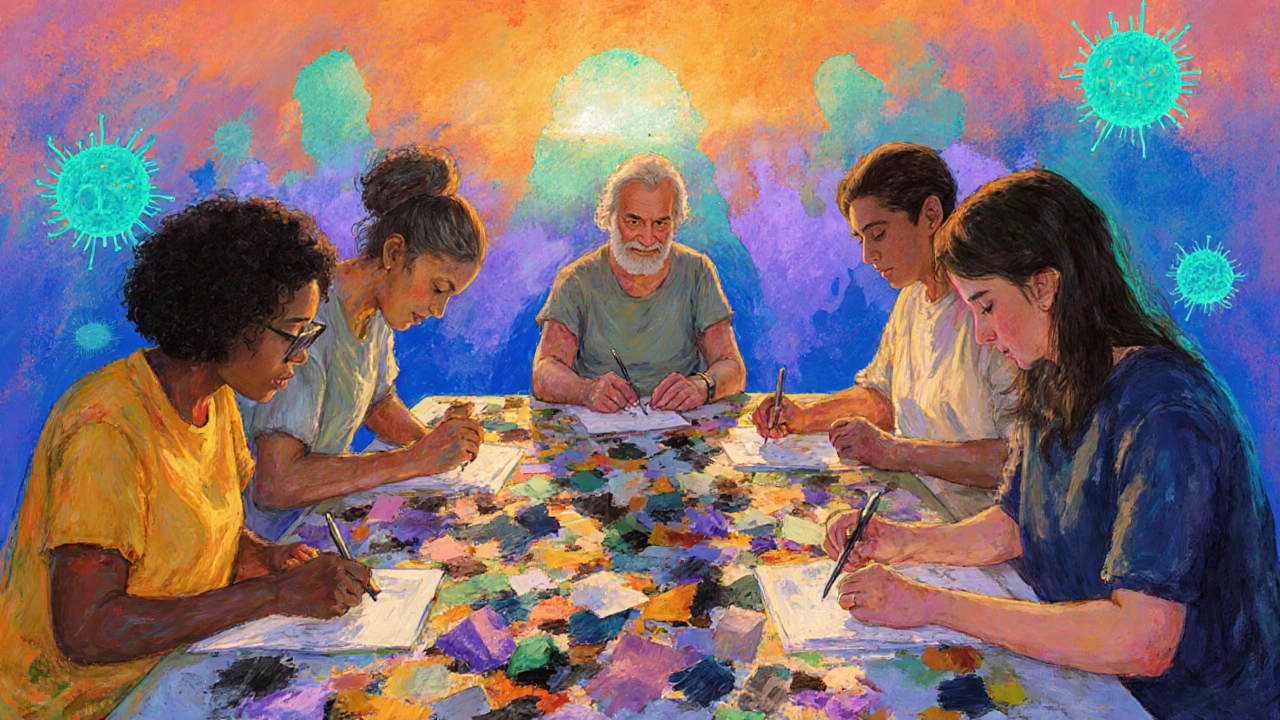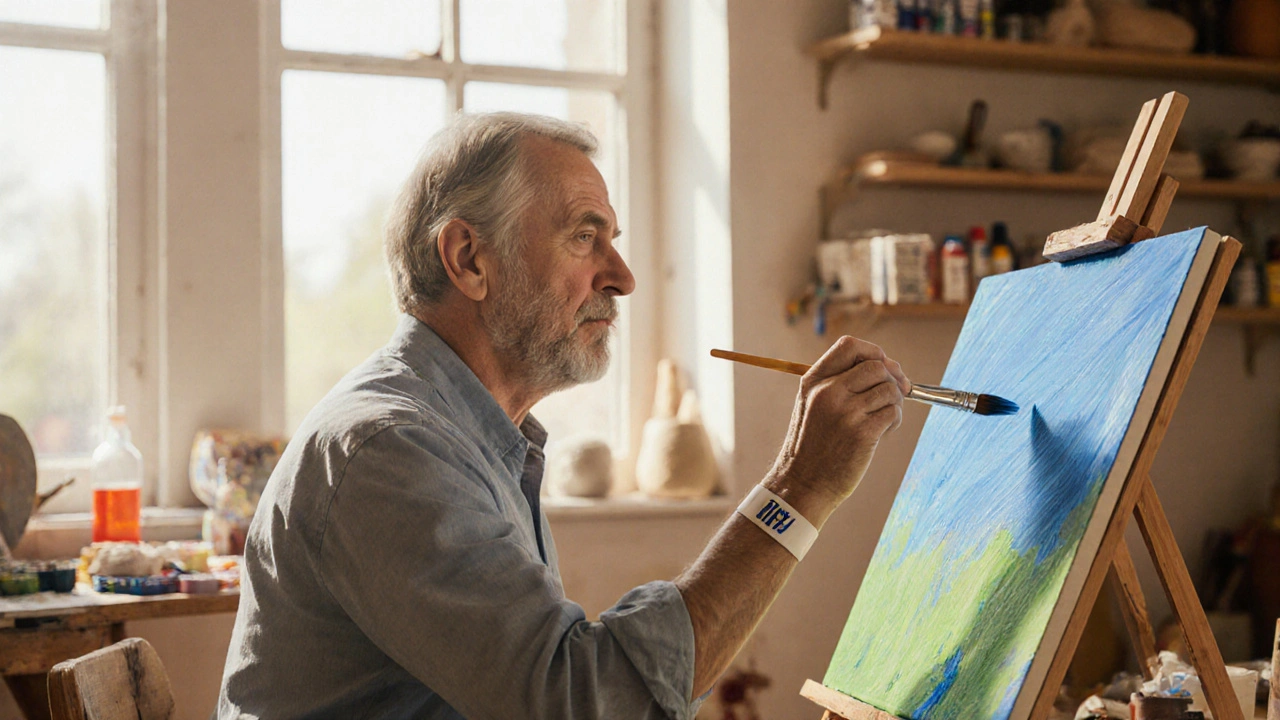HIV Art Therapy Impact Calculator
Enter values and click calculate to see estimated benefits.
About This Calculator
This tool estimates potential emotional and immune benefits based on research findings. Actual results may vary. Results are not medical advice.
Living with HIV is a physical journey, but the emotional road can feel even rougher. Many people wonder if there’s a way to ease anxiety, combat stigma, and boost overall wellbeing without relying solely on medication. That’s where art therapy steps in - a structured, creative process that turns paint, music, or movement into a powerful coping tool.
- Art therapy helps process trauma and reduces stress.
- Creative expression can improve immune markers like CD4 count.
- It offers a safe space to confront stigma.
- Therapists tailor activities to each person’s needs.
- Progress is measurable through mood scales and medical outcomes.
Understanding the Mental Load of HIV
When the immune system is challenged, the brain often bears the brunt. Studies from the Global Health Institute in 2024 show that up to 40% of people living with HIV experience clinically significant anxiety. The constant reminder of medication schedules, potential side effects, and societal judgment fuels a cycle of stress that can suppress the immune system itself. Elevated cortisol, the body’s stress hormone, has been linked to lower CD4 counts, which are critical for tracking disease progression.
What Exactly Is Art Therapy?
Art therapy is a licensed mental‑health practice that uses the artistic process-not the final product-to explore feelings, resolve conflicts, and develop skills. A certified art therapist guides participants through activities like drawing, collage, dance, or digital media, encouraging reflection without forcing verbal disclosure. Unlike casual “hobby time,” the therapist sets therapeutic goals, monitors emotional responses, and integrates the work with other treatments such as antiretroviral therapy (ART).
Evidence: How Creative Expression Impacts HIV Healing
Research from the University of Cape Town (2023) followed 120 adults on ART for six months. Those who attended weekly art‑therapy sessions reported a 30% drop in depressive symptoms and a modest 5‑point rise in CD4 count compared to a control group. Another trial in the United States measured cortisol levels before and after a music‑making workshop; participants showed a 22% reduction in stress hormones immediately after the session.
Key takeaways from the data:
- Emotional release: Creating art provides a non‑verbal outlet for hidden fears.
- Community building: Group projects reduce feelings of isolation.
- Neuro‑plastic benefits: Engaging the right‑brain fosters new coping pathways.
- Medical synergy: Lower stress can improve medication adherence and immune response.
Getting Started: Practical Ways to Use Creative Expression
Not sure where to begin? Here’s a step‑by‑step starter kit you can try at home or in a clinic setting.
- Choose a medium - paint, charcoal, clay, or even smartphone photography.
- Set an intention - ask yourself, “What emotion am I inviting today?”
- Create without judgment - focus on the process, not the product.
- Reflect - write a short note about any thoughts or memories that surfaced.
- Share (optional) - discuss your piece with a trusted friend or therapist.
For those who prefer guided sessions, many hospitals now host weekly art‑based interventions. Look for programs labeled “Healing Through Creative Expression” or “HIV Support Art Groups.”

Choosing the Right Art Therapist
Credentials matter. A qualified professional will hold a master's degree in art therapy and be registered with a national board (e.g., American Art Therapy Association or UK Society for Art Therapy). When you contact a therapist, ask about:
- Experience with chronic illness, especially HIV.
- Approach to cultural sensitivity - can they incorporate Maori or Polynesian motifs if you’re from New Zealand?
- Integration with your medical team - are they comfortable sharing insights with your doctor?
Cost varies by region. In New Zealand, public health clinics often subsidize sessions, while private practitioners might charge NZ$80‑$120 per hour.
Measuring Success: What to Track
Progress isn’t just about beautiful paintings. Use a blend of subjective and objective markers:
- Mood diaries - rate anxiety on a 1‑10 scale before and after each session.
- Medical metrics - track CD4 count and viral load quarterly.
- Engagement levels - note attendance frequency and willingness to try new media.
When you see a steady mood improvement alongside stable or rising CD4 numbers, you’ve likely hit a therapeutic sweet spot.
Art Therapy vs Traditional Talk Therapy: A Quick Comparison
| Aspect | Art Therapy | Talk Therapy |
|---|---|---|
| Primary Mode | Creative process (visual, musical, kinesthetic) | Verbal conversation |
| Stigma Sensitivity | High - non‑verbal can bypass shame | Moderate - requires opening up verbally |
| Evidence for Immune Impact | Positive correlations with CD4 rise (small‑scale studies) | Limited direct immunological data |
| Typical Session Length | 60‑90 minutes (includes creation & reflection) | 45‑60 minutes |
| Best For | Clients who struggle with words, enjoy hands‑on activity | Clients comfortable discussing thoughts aloud |
Addressing Common Concerns
“I’m not artistic.” - No talent required. The therapist focuses on the act, not the aesthetics.
“Will this replace medication?” - Absolutely not. Art therapy is complementary; you should continue ART as prescribed.
“What if I feel emotional overload?” - A trained therapist will set boundaries and offer grounding techniques.
Frequently Asked Questions
Can art therapy help reduce HIV‑related stigma?
Yes. Group art projects create a sense of belonging and allow participants to share stories indirectly, which can dismantle misconceptions and foster empathy among peers.
How often should I attend art‑therapy sessions?
Most programs recommend weekly 60‑minute sessions for at least three months to see measurable emotional and physiological benefits.
Is art therapy covered by health insurance in New Zealand?
Public district health boards often subsidize mental‑health services, including art therapy, for patients with chronic illnesses. Private insurers may require a referral from a GP.
Do I need any special materials?
Your therapist will usually supply basic supplies. If you’re working at home, simple items like sketch pads, colored pencils, or a digital drawing app are enough.
Can art therapy improve my CD4 count?
Direct causation is still under study, but reduced stress from creative work has been linked to modest CD4 improvements in several pilot trials.
Whether you’re newly diagnosed or have been managing HIV for years, adding a creative outlet can tilt the balance toward resilience. Pair it with your antiretroviral regimen, talk to your care team, and give yourself permission to play - your mind, body, and immune system will thank you.


7 Comments
Mandy Mehalko
Art therapyy is awesome, give it a try!
Bryan Kopp
I don't see the point of painting when the pills already do the work.
Patrick Vande Ven
Art therapy, when applied to individuals living with HIV, operates on a well‑established biopsychosocial framework.
First, the creative process engages neural circuits implicated in emotional regulation, thereby attenuating hyper‑active amygdala responses.
Second, group‑based art sessions foster social cohesion, which has been shown to mitigate perceived stigma.
Third, the act of externalising internal experiences reduces cortisol secretion, a neuroendocrine marker linked to CD4 decline.
Empirical evidence from the University of Cape Town (2023) demonstrated a statistically significant 5‑point increase in CD4 count among participants receiving weekly art‑therapy adjuncts.
Parallel research in the United States observed a 22 % reduction in salivary cortisol following a single music‑making workshop.
These physiological shifts, while modest, suggest that art therapy can complement antiretroviral therapy by stabilising immune parameters.
The therapeutic alliance, however, is pivotal; only certified art therapists with experience in chronic illness should facilitate sessions.
Credentialing bodies such as the American Art Therapy Association mandate a master's degree and supervised clinical practice.
Patients are advised to verify that their therapist integrates culturally relevant motifs, particularly when addressing diverse populations.
Insurance coverage varies; in New Zealand, district health boards often subsidise services for chronic disease management.
In the United States, a physician referral may be required for private insurers to reimburse.
Practically, a starter kit can consist of sketch paper, charcoal, and a reflective journal; the therapist supplies additional materials as needed.
Outcome measurement should combine subjective mood scales with objective laboratory markers, recorded quarterly.
Finally, while art therapy should never replace pharmacological treatment, it represents a low‑risk, high‑reward adjunct that can enhance overall wellbeing.
Tim Giles
Building on the evidence presented, it is worthwhile to consider the longitudinal implications of sustained creative engagement.
A consistent schedule of weekly sessions enables neuroplastic adaptations that extend beyond immediate stress relief.
Moreover, the collaborative nature of group art fosters peer support networks, which are crucial for adherence to antiretroviral regimens.
While the data are promising, further randomized controlled trials are necessary to delineate causality between artistic activity and immune function.
Clinicians should remain vigilant for potential emotional overwhelm, ensuring that grounding techniques are integrated into each session.
In practice, integrating brief reflective writing after the creative component can consolidate insights and track progress over time.
Peter Jones
Really glad to see this conversation. Creative outlets can make a huge difference, especially when the medical route feels overwhelming.
Gerard Parker
For anyone looking to start, I recommend checking local HIV clinics – many now have art‑therapy programs run by certified therapists.
Don’t hesitate to ask about cultural sensitivity; a therapist who respects your background can tailor the medium to resonate with you.
If cost is a concern, ask about sliding‑scale fees or community grants – there’s often hidden support.
Thomas Burke
Just tried a simple doodle session at home – didn't even need fancy supplies and felt a calm wash over me.
Give it a shot, no pressure.